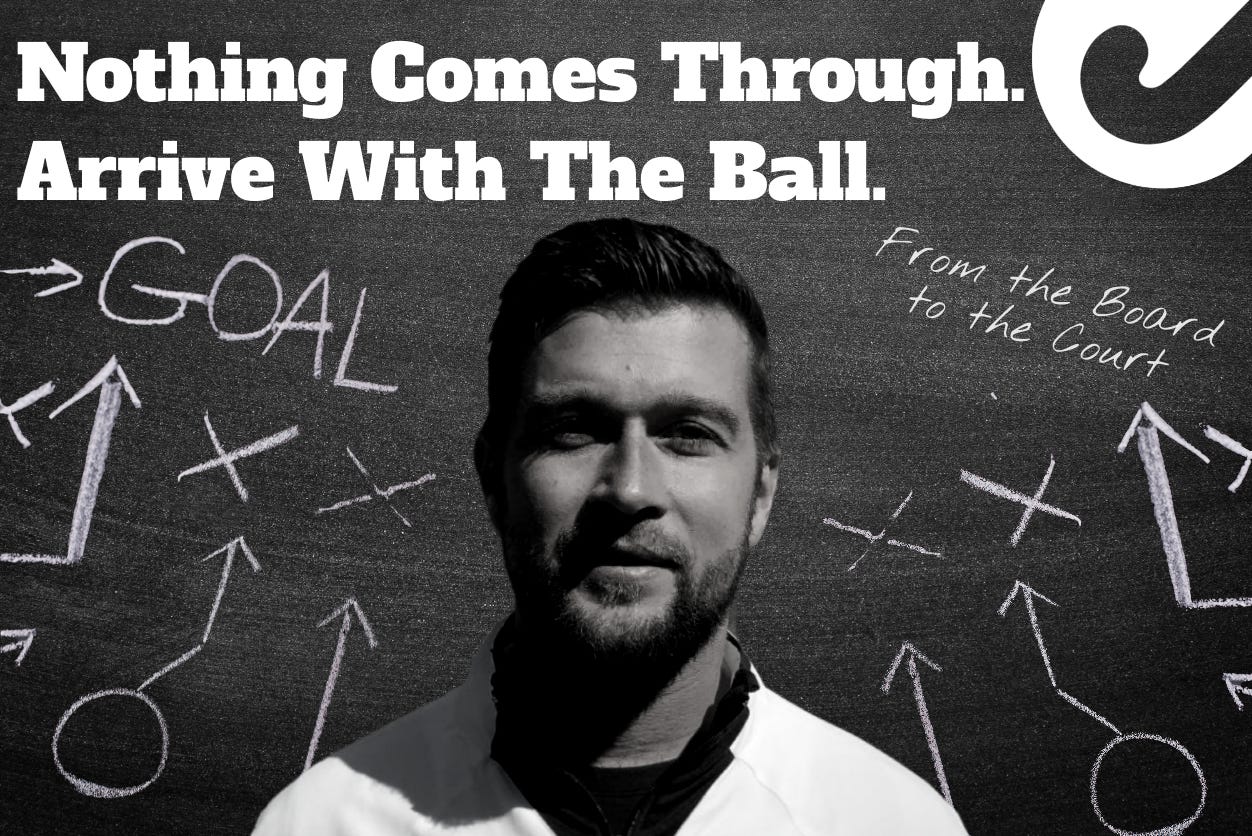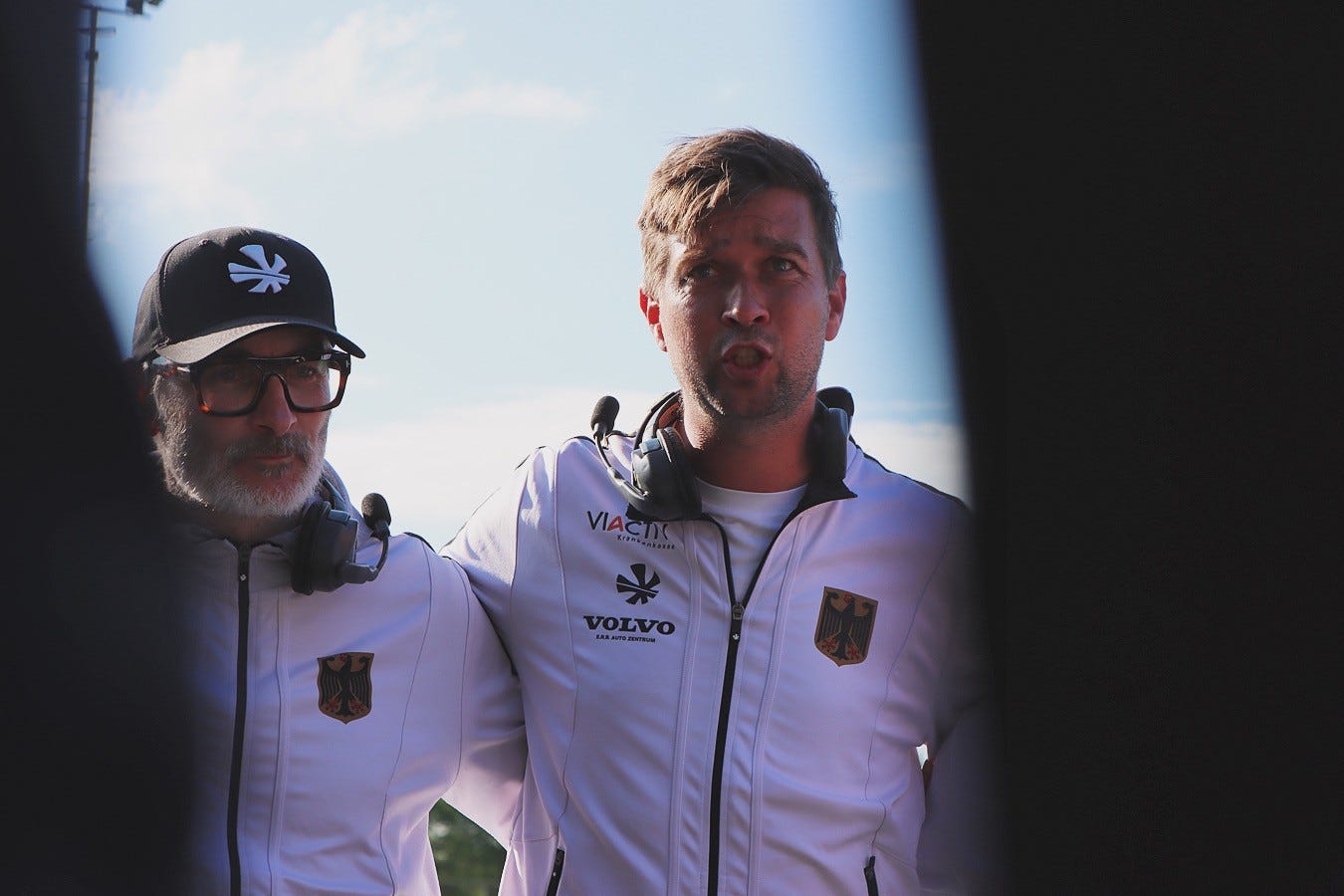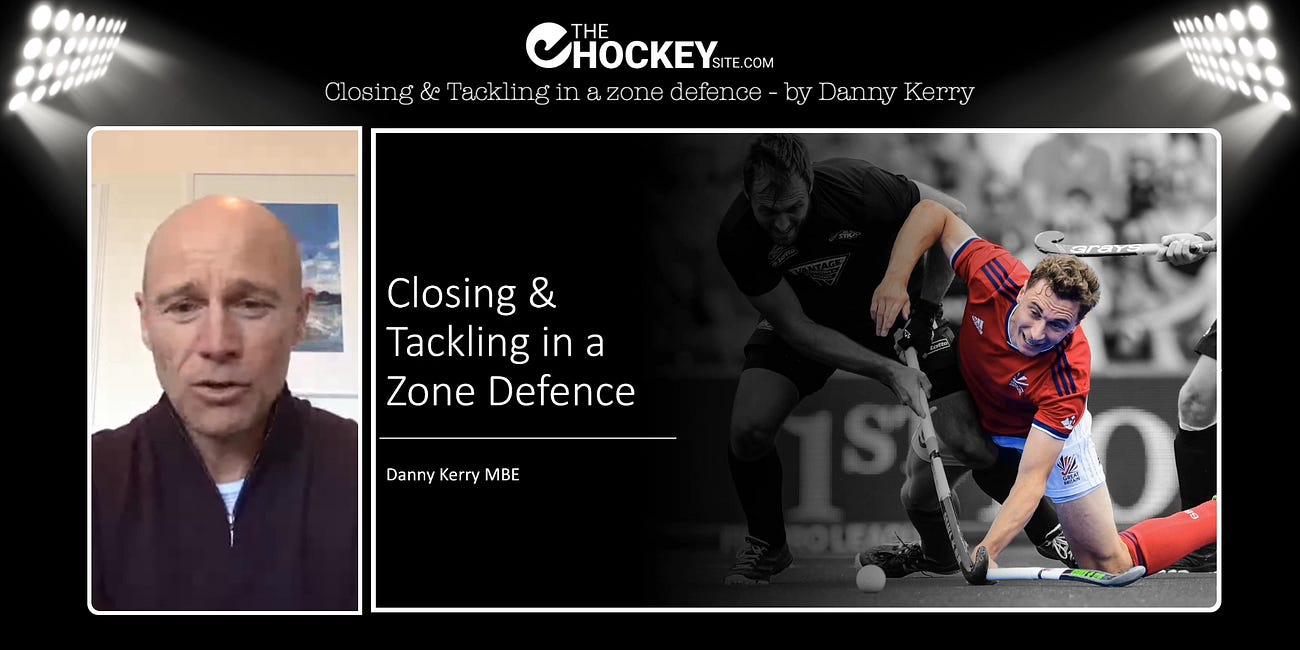Nothing Comes Through. Arrive With the Ball.
From the Board to the Court: a series of articles by Rein van Eijk to explore the tactical layers, performance truths, and lived principles behind high-level hockey.
This article marks the start of a new series by Rein van Eijk, head coach for the national women’s team of Belgium:
From the Board to the Court. In this series I will try to explore the tactical layers, performance truths, and lived principles behind high-level hockey. Starting with a look at what truly defines elite defending, not in systems, but in shared beliefs and epecially principles.
In Hockey, few topics stir as much whiteboard passion as defending. It's one of those conversations that crackles with energy from the first word. Say "man-marking," "zone," or "hybrid," and you'll usually trigger a chain reaction: arms waving, triangles sketched furiously on coffee-stained napkins, arrows flying through imaginary passing lanes. Everyone's got their version of the truth, and they’re ready to defend it—ironically, often with more aggression than their back four ever showed.
I’ve sat in those sessions. I’ve argued across benches, scribbled over diagrams in coaching courses, and exchanged voice notes about defensive triggers while walking through cities I barely knew. And what I’ve learned is this: defending isn’t just a tactical decision—it’s a language, a worldview, a culture. And when it’s done well, it’s a thing of beauty. It's more than stopping goals. It’s about clarity, unity, and the invisible trust between teammates that makes the whole system breathe.
But if I’ve learned anything over the past 15 years, it’s this: structure might shape your defense, but principles define it.
Principles are different from tactics or strategies. Principles are truths that remain valid across all systems, all game plans, and all levels of the sport. They're like anchors in a storm. Whether you're defending a sideline free hit or pressing in the final minutes of a semifinal, principles guide decision-making. They help players find clarity in chaos. They apply to the team, but they also empower the individual. In every moment of the game, a principle offers orientation, it offers something to lean on when patterns break down and improvisation kicks in. Whilst every team may defend differently on paper, the ones that truly excel; the ones that defend consistently, collectively, and under pressure, tend to share a common DNA. A shared rhythm. A shared promise. They are built on two core commitments that show up time and time again, no matter the nation, the jersey, or the moment:
Nothing comes through. Arrive with the ball.
These are not tactics. These are not formations. They are principles—always true, no matter the moment, the system, or the scoreboard. Much like the coaching philosophies of John Wooden or Anson Dorrance, principles exist to guide players under pressure. They offer clarity where the game offers chaos. They aren't tied to a particular style—they are timeless truths that help individuals and teams find solutions in unpredictable, real-time scenarios..
This way of seeing defending, stripped down to its essence, didn’t come to me overnight. It was shaped over years, through mistakes, through trial and error, through sessions that worked and plenty that didn’t. But it was sharpened – greatly so – by sharing ideas and work with people who understood the game at a level that made me rethink what I thought I knew.
One of those people is russell garcia.
Russell has been more than just a coaching colleague; he’s been a sounding board, a mentor, and a kind of mirror. To me, he is one of the great minds in hockey. In working with him, I saw the difference between cluttered defending and connected defending. He has a gift for turning complexity into clarity. When we coached together, he didn’t overwhelm players with concepts. He challenged them to commit to the few things that actually shape performance.
I can vividly remember how many of our conversations, often informal, walking off a pitch or watching clips in a meeting room or any hotel. These conversations always circled back to the same truths: defending isn’t about what formation you use. It’s about what you’re willing to give away.
And that, right there, was the bridge into a philosophy that had been forming in me for years.
I’ve never believed that being a coach means solely being the author of a tactical identity. If anything, the longer I coach, the more I feel like a translator, someone who listens, observes, and helps turn complexity into clarity. What we draw on the board might look smart in a meeting room, but it’s only ever as good as what it brings to life on the court. A system is just scaffolding. The substance comes from the people inside it.
These principles, ‘nothing comes through’ and ‘arriving with the ball’, aren’t about style or preference. They’re not about whether you defend high or sit back, mark man-to-man or guard a zone. They are about a shared understanding that transcends shape, and more importantly, transcends uncertainty. They offer orientation when things go off-script. They give players a way to solve problems in real time. Not by guessing, but by returning to something they trust.
They’re not just defensive tools. They’re connection points. Because when a team shares those principles – when they defend with a common purpose – they don’t just stop attacks. They start believing in each other more deeply.
And that belief? That’s where the good stuff begins.
What’s your take? Are these principles part of your team’s language? Do your players live them, or just learn them? Let’s keep this conversation going. Because if defending is a language, it’s one we’re all still learning to speak more fluently.
Principle 1: Nothing Comes Through
If I had to pick a single sentence to define elite-level defending, this would be it.
Nothing comes through.
It’s more than a mindset. It’s a commitment. It’s a demand. It’s the one non-negotiable that has to live in every defender’s body language, positioning, and choices—whether they’re playing man, zone, or something in between.
When we say nothing comes through, we don’t mean “try your best.” We mean it doesn’t happen. No passes through. No slips behind. No loose players ghosting through zones. It’s about accountability—not just as a team, but as an individual. If you’ve been assigned a player, they don’t get the ball clean. If you’re responsible for a space, no one plays through it unchallenged. That’s the level. That’s the standard.
Defending like this is more than just executing a tactic. It’s a way that transcends formations. It’s the foundation of defensive identity. It’s about owning your role and giving your teammates confidence that the job will get done—and holding them to the same standard in return. It shows up when the forward presses with full conviction to start the chain reaction. It shows up when the weak side defender stays mentally connected to the play even though the ball is on the opposite side of the pitch. And most of all, you see it in the moments that don't make highlight reels—the inch closed just in time, the body thrown into a passing lane, the teammate who didn't point fingers but stepped forward instead. These aren’t just habits. They’re reflections of a principle: not through me. Not through my line. Not through this team.
This principle is not about style. It’s about substance. About refusing to accept gaps. About saying: this is mine, this is ours, and you’re not getting through.
It aligns with the idea of constraint-led learning, in which we shape players through the challenge, not the drill. Nothing comes through isn’t a command. It’s a constraint. A demand that calls for adaptation and accountability. And those, in the end, are what grow elite defenders.
This principle was carved into my understanding during my years in Germany, a country where the art of defending isn’t just respected—it’s expected. In German hockey culture, Teams aren’t just defensively solid, teams and their players properly take pride in denying space.
When I was coaching Berliner HC with Martin Häner - by far the smartest defender I have ever worked with so far. He wouldn’t just defend space. He made the space his. Regardless, whether behind a disciplined man-marking or zonal marking system, Martin read the game like a chessboard. He seemed to move before the pass had even been made. That experience changed the way I looked at defensive structures. It deepened my appreciation for the discipline and positioning required. Not just from one player, but from a whole unit who decides, collectively: nothing comes through.
And the beauty of it is, it doesn’t matter what your setup is. Once your team begins to feel that—it changes everything. You can play a deep block. A high press. You can play a hybrid system that morphs with every restart. If your players are wired to keep everything out, to hold that line with pride and purpose, you’ve got the foundation of something meaningful. That’s how defensive units earn trust. That’s how they grow belief. Not through complexity. Through commitment.
Principle 2: Arrive With the Ball
If “nothing comes through” is about sealing the wall, then “arrive with the ball” is about timing the confrontation. In elite hockey, being nearby isn’t enough. Defenders must meet the attacker in the exact heartbeat when the ball is received, interrupting flow before it begins. You have to be present at the moment it matters. At that exact moment when the ball lands at an opponent’s stick, when their eyes lift to scan the field, when a seemingly harmless pass suddenly threatens to become something more.
Arriving with the ball means applying pressure at the first touch. It’s stepping up with purpose the moment a pass is played, not seconds later. Arriving with the ball means denying time, limiting space, and putting the attacking player on someone else’s terms. Not theirs. Yours.
The concept might sound straightforward, but executing it consistently is anything but. To arrive with the ball, defenders need anticipation, awareness, and a deep understanding of the flow of the game. It’s a principle rooted in proactive behavior. You can’t just react to what’s happening; you have to read what’s coming next. You have to move with intention.
I saw this principle fully come alive during the Junior World Cup with the German U21 team, a team that many praised for its flexibility between man and zonal marking. But what truly set them apart, in my eyes, was their anticipation; their capacity to read the pass before it landed, and step into it with conviction. Our forwards disrupted rhythm before it started. Midfielders pinched space out of nothing. And defenders didn’t just react; they pre-empted. That’s not luck. That’s a principle applied.
Great defending is about more than positioning—it’s about arrival. Timely, purposeful arrival. It leads to more turnovers, more forced errors, more defensive rhythm. Your team will start dictating.
This principle also brings responsibility. Because arriving with the ball requires that you trust your teammates. You trust them to not just be there, but to act in time, to step with you, and to see the same moment as crucial. It’s the kind of synchronized movement you also see in sports like rugby, where defensive lines rise together to cut down options, or in basketball, where a full-team switch or help-defense only works if everyone moves together the moment a ball-handler turns the corner. That trust between players, across units, is what allows anticipation to turn into action, and effort into outcome. to be doing the same. You step with the belief that the space behind you will be covered. That your effort won’t go to waste. That you are part of a larger movement. A tide that rises and presses as one.
It’s easy to see this principle in clips. But its real power is felt in the quiet moments. That moment when the intercepted ball leads to a counter; the pressure that forces a wild hit; or the forced back pass that gives your team a breath and a reset.
Because in elite sport, presence is pressure and time is like oxygen. And if you arrive with the ball, you don’t just limit options. You take control. you will take that oxygen away.
Let’s make sure our players know: we don’t just want them to run. We want them to arrive. On time. With purpose. And with presence.
And if you're coaching or playing: what are you doing to help your team arrive with the ball? How are you helping them feel the timing, understand the rhythm, and commit to the moment when it truly matters?
The conversation continues—on the court, in the locker room, and right here.
Creating Conditions: Staying Compact & Mirroring
So if those two principles—nothing comes through and arrive with the ball—form the foundation, how do we increase the chances that these principles come to life on the field? That’s where two supporting concepts matter, and two of the most important ones are staying compact and mirroring.
Staying Compact
Compactness isn’t about being passive. It’s about being connected. A compact unit is a unit that moves together. It keeps the distance between the player closest to the ball and the one furthest away short enough to maintain control. Whether you’re reasoning from front to back, or from side to side, that distance matters. Because the more stretched you are, the more space you leave for the opponent to exploit, and the less likely it becomes that nothing comes through.
When you’re compact, you make supporting easier. Recovering becomes quicker. Covering becomes natural. Traps become tighter. And the collective starts to act as a single organism, with the intelligence and intensity to suffocate play before it turns dangerous.
It’s something I saw up close during my stays in India. There, defending sometimes looks unstructured to the outside eye. But it isn’t. At its best, Indian defending is intuitive and rhythmic. When done well, the whole team slides as a block, closing gaps, moving with feeling, almost like music. And when they stay compact, it becomes incredibly hard to break them down.
Mirroring
Mirroring is what brings intelligence to compactness. It’s how players orient themselves in relation to ball, teammates, and opponents—not just statically, but dynamically. In zonal defending especially, mirroring is the difference between being present and being purposeful.
Mirroring means understanding where the ball is, where your teammates are, and where the opponent is positioning themselves. It’s the spatial awareness that makes both of the principles work. It’s not just about sticking to a man or holding a zone—it’s about sensing where your presence can make the most difference.
For example in zonal systems, Mirroring is a concept is of elementary importance. Because zones don’t defend themselves. Players do. And if you don’t read the number of opponents in your area—if you don’t adjust to an overload or a positional threat—you’ll be standing in a zone while the game is being played around you.
Good mirroring is about asking: where is the threat? Who is active? What do I take away by stepping here, not just for me, but for the group? It’s an orientation mechanism that makes you a living, breathing part of the collective.
Mirrorring is a mindset, not a map. You don’t just hold a position. You hold an understanding.
Together, compactness and mirroring are the invisible glue. They give your players tools to apply the principles. They make defending more than organized. Not just in theory, but especially in the chaos of a fast-moving match.
And if you're wondering: yes, every system eventually blends. I am convinced that at some point, every zonal system demands you take responsibility for a player. And every man-to-man setup has to shift into covering space. That’s why principles matter most. And why these concepts can be there to support them.
Beyond the Board: Rhythm, Responsibility & the Identity of Defending
At some point, defending stops being about Xs and Os. It stops being about formations, arrows, or how many players sit behind the ball. What matters at a certain point is how your team feels the game together.
Great defending isn’t just technical. It’s not just tactical. It’s emotional. It’s relational. It lives in rhythm, responsibility, and the invisible threads that tie players together when the pressure mounts.
There’s something that happens when a team defends with more than just logic. When it becomes less about instructions and more about instinct. It is a rhythm. Rhythm is what makes defending come alive. It’s not something you can draw. It’s something that must be felt. The way a striker’s press triggers the midfielder’s step. The way a defender anticipates the need to close space before a pass is even made. This is the rhythm of trust. Of shared anticipation. Of players moving not because they were told, but because they just know. It’s not a callout. It’s a current.
Good rhythm can’t be scripted. It has to be felt. Like jazz. Like choreography. Like a perfectly timed counter where nobody speaks, but everybody moves in harmony. Teams that defend in rhythm are a nightmare to break down. Not because they’re rigid, but because they’re united. They shift before the ball shifts. They fill gaps before they open. They act as one. Everyone feels the beat. And each of the players therefore moves as one.
And then there is responsibility. Responsibility, on the other hand, is what takes rhythm and gives it backbone. It’s not enough to move in sync. You have to own your role in the symphony. In great teams, defending isn’t a task. It’s a mindset. It’s a commitment players make to one another. You don’t let your opponent through—not because the coach said so, but because it’s your space, your moment, your job.
And it spreads. One player who truly takes responsibility. One player who leads through action, who steps forward into danger without waiting. This player can raise the level of everyone around them. Responsibility is contagious. It builds belief. It creates culture.
Which leads to the final layer: identity.
The very best defensive units I’ve ever worked with – whether it was with club teams in Berlin, national players in Belgium, or youth squads in Germany – had one thing in common: defending was part of who they were. It wasn’t something they did when they lost the ball. It was something they believed in. It shaped their behavior. It gave them pride. It created a shared sense of purpose.
You can’t fake that. You build it with time. With intention. With principles that become habits. With habits that become standards. And standards that, over time, create identity.
And once it clicks? Once players know what to expect from one another, not because it’s on a whiteboard, but because it’s in their bones, you get a team that doesn’t just defend well. You get a team that lives its defense. A team that communicates without words. That trusts. That works. That refuses to be broken.
And that, for me, is the highest level we can reach—not just as coaches, but as teams. To play in a way where every movement speaks. Where every action echoes a deeper belief. Where defending isn’t just part of the game. It is the game.
So let’s keep teaching the details. Let’s keep sharpening the systems. But let’s never lose sight of what lies underneath it all: a rhythm that connects, a responsibility that binds, and an identity that says—we don’t just want to win. We want to defend like it matters.
Because in the end, what we defend… we become.
In every coaching journey, there are voices who help you see the game more clearly. For me, one of those voices has been Russell Garcia. His clarity of thought, his way of distilling the complex into the essential, has deeply shaped how I see defense as a matter of principle and clarity.
If you've made it this far, thank you for diving into the depths with me. This piece is part of a broader series: From the Board to the Court. In this series I will try and share ideas, reflections, and coaching philosophy from my world of high-performance hockey. I hope it sparks questions, conversations, maybe even a shift in how you teach or play.
If something resonated, feel free to share it with a colleague, bring it up in your next session, or even better: drop a comment. Because for me the best part of coaching isn’t just what I know. It is what I continuously get to learn, together with those around me.
Let nothing come through. Arrive with the ball. Stay compact. Mirror what matters.
About Rein van Eijk
Red Panthers Head Coach | Culture, coffee & counterpress | Helping good players become great teammates | One pass at a time
Another interesting masterclass on defending ↓
Closing and tackling in a zone defence
A masterclass by Danny Kerry (ENG) on closing & tackling in a zone defence. A topic that challenged him when he took over the English and GB national men’s team and introduced new tactics in the lead up to the Tokyo Games.






